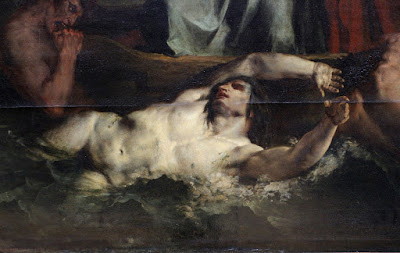 |
| Eugène Delacroix Study for the Damned in The Barque of Dante ca. 1822 drawing Musée du Louvre |
 |
| Eugène Delacroix Study for the Damned in The Barque of Dante ca. 1822 drawing Musée du Louvre |
 |
| Eugène Delacroix The Barque of Dante (detail) 1822 oil on canvas Musée du Louvre |
 |
| Eugène Delacroix The Barque of Dante 1822 oil on canvas Musée du Louvre |
 |
| Eugène Delacroix Study for Heads of Dante and Virgil in The Barque of Dante ca. 1822 drawing Musée du Louvre |
 |
| Eugène Delacroix Study for The Barque of Dante and other Studies ca. 1822 drawing, with watercolor Musée du Louvre |
 |
| Eugène Delacroix Atmospheric Study for The Barque of Dante ca. 1822 watercolor Musée du Louvre |
 |
| Eugène Delacroix Study for the Damned in The Barque of Dante ca. 1822 drawing Musée du Louvre |
 |
| Eugène Delacroix Study for the Damned in The Barque of Dante ca. 1822 drawing Musée du Louvre |
"Romanticism and colour lead me straight to Eugène Delacroix. I do not know if he is proud of his title of 'romantic', but his place is here, because a long time ago – from his very first work, in fact – the majority of the public placed him at the head of the modern school.
As I enter upon this part of my work, my heart is full of a serene joy, and I am purposely selecting my newest pens, so great is my desire to be clear and limpid, so happy do I feel to be addressing my dearest and most sympathetic subject. But in order to make the conclusions of this chapter properly intelligible, I must first go back some little distance in the history of this period, and place before the eyes of the public certain documents of the case which have already been cited by earlier critics and historians, but which are necessary to complete my demonstration. Nevertheless, I do not think that true admirers of Eugène Delacroix will feel anything but a keen pleasure in re-reading an extract from the Constitutionnel of 1822, taken from the Salon of M. Thiers, journalist –
In my opinion no picture is a clearer revelation of future greatness than M. Delacroix's Le Dante et Virgile aux Enfers. Here above all you can recognize the spurt of talent, that burst of dawning mastery which revives our hopes, already a trifle dashed by the too moderate worth of all the rest.
Dante and Virgil are being ferried across the infernal stream by Charon; they cleave their way with difficulty through the mob which swarms round the barque in order to clamber aboard. Dante, pictured alive, bears the dreadful taint of the place: Virgil, crowned with gloomy laurel, wears the colours of death. The hapless throng, doomed eternally to crave the opposite bank, are clinging to the boat: one is clutching at it in vain, and, thrown backwards by his precipitate effort, plunges once more into the waters; another has hold, and is kicking back those who, like himself, are struggling to get on board; two others are gripping at the elusive timber with their teeth. There you have all the egoism of misery, the despair of Hell. In a subject which borders so closely on exaggeration, you will yet find a severity of taste, a propriety of setting, so to say, which enhances the design, though stern judges – in this case ill-advised – might perhaps criticize it for a lack of nobility. It is painted with a broad, firm brush, and its colour is simple and vigorous, if a trifle raw."
– from The Salon of 1846, published in Art in Paris, 1845-1862: Salons and Exhibitions reviewed by Charles Baudelaire, translated and edited by Jonathan Mayne (London: Phaidon Press, 1965)
 |
| Eugène Delacroix Death of Sardanapalus 1827 oil on canvas Musée du Louvre |
 |
| Eugène Delacroix Death of Sardanapalus (detail) 1827 oil on canvas Musée du Louvre |
 |
| Eugène Delacroix Death of Sardanapalus (detail) 1827 oil on canvas Musée du Louvre |
 |
| Eugène Delacroix Study for Death of Sardanapalus ca. 1827 drawing (colored chalks) Musée du Louvre |
 |
| Eugène Delacroix Study for Death of Sardanapalus ca. 1827 drawing (colored chalks) Musée du Louvre |
 |
| Eugène Delacroix Study for Death of Sardanapalus ca. 1827 drawing (colored chalks) Musée du Louvre |